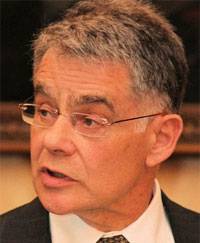
|
| Dr. Patrick Pullicino |
Dr. Patrick Pullicino, a consultant neurologist for East Kent Hospitals and Professor of Clinical Neurosciences at the University of Kent, claimed that doctors are putting people on the LCP without proper analysis of their condition, citing “pressure on beds and difficulty with nursing confused or difficult-to-manage elderly patients” as factors.
According to the Daily Mail, the doctor sounded the alarm that of the approximately half million deaths in Britain each year of elderly people who are in hospital or under NHS care, about 29 percent, or 130,000, are patients who were on the LCP.
The Liverpool Care Pathway, developed by the Royal Liverpool Hospital and the Marie Curie hospice in the 1990s, and described by its formulators as a “template” to guide the care of the dying, was approved in 2004 by the National Institute for Health and Clinical Excellence (NICE), the government’s health scrutiny body in charge of rationing health services.
The LCP, reportedly adopted nationwide by more than 300 hospitals, 130 hospices and 560 care homes in England, allows for withdrawal of water and nourishment, and “continuous deep sedation” for patients judged to be incurable. Combined with withdrawal of fluids, deep sedation leads quickly to death.
Pullicino related the personal experience of removing a man from the LCP who went on to live another 14 months, proving that the claim of the diagnosing doctor that the man had only hours to live was “palpably false.”
“I found him deeply unresponsive on a Monday morning and was told he had been put on the LCP. He was on morphine via a syringe driver. I removed the patient from the LCP despite significant resistance,” Pullicino told the Royal Society of Medicine. “His seizures came under control and four weeks later he was discharged home to his family.”
“The lack of evidence for initiating the Liverpool Care Pathway makes it an assisted death pathway rather than a care pathway,” Pullicino stated. “Very likely many elderly patients who could live substantially longer are being killed by the LCP.
“Predicting death in a time frame of three to four days, or even at any other specific time, is not possible scientifically. This determination in the LCP leads to a self-fulfilling prophecy. The personal views of the physician or other medical team members of perceived quality of life or low likelihood of a good outcome are probably central in putting a patient on the LCP.”
“If we accept the Liverpool Care Pathway we accept that euthanasia is part of the standard way of dying as it is now associated with 29 per cent of NHS deaths,” Dr. Pullicino concluded.
According to the Daily Mail, a Department of Health spokesman panned Dr. Pullicino’s assertions. “The Liverpool Care Pathway is not euthanasia and we do not recognise these figures. The pathway is recommended by NICE and has overwhelming support from clinicians – at home and abroad – including the Royal College of Physicians,” the unnamed spokesman said.
However, Pullicino’s claims echo a similar statement last year by Dr. Clare Walker, President of the Catholic Medical Association in the UK, where she said, “euthanasia is being widely practiced in the NHS in an official way” under the LCP protocol.
Dr. Walker explained that “she is regularly contacted by distressed healthcare professionals and managers who describe their experience of witnessing repeated instances of unofficial active euthanasia in their local areas,” adding that, “in some hospitals the LCP has become known as the Lazarus Care Pathway due to the number of people who have been put on it inappropriately, are not moribound and subsequently need to be actively treated.”
Alex Schadenberg, Executive Director of Canada’s Euthanasia Prevention Coalition, responded to Dr. Walker’s statement at the time, saying, “Whether active euthanasia is actually widespread is unknown and anecdotal at best but the reality is that the Euthanasia Prevention Coalition regularly receives phone calls and emails from family members and friends of people whose medical care-givers appear to be intentionally causing their death.
“Many of these cases are concerned family members reacting to end of life decisions that are made because the person is actually dying, whereas, sometimes these cases appear to be euthanasia.”LONDON, June 21, 2012 (LifeSiteNews.com) - An eminent British doctor told a meeting of the Royal Society of Medicine in London that every year 130,000 elderly patients that die while under the care of the National Health Service (NHS) have been effectively euthanized by being put on the controversial Liverpool Care Pathway (LCP), a protocol for care of the terminally ill that he described as a “death pathway.”
